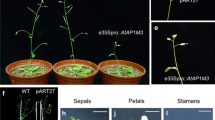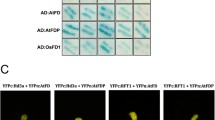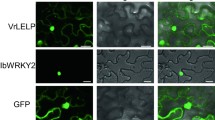Abstract
The homozygous T-DNA mutants of AtCAL1 (Rat1) and AtCAL2 (Rat2) were obtained. The double mutant of Rat2/Rat1RNAi was constructed which showed obvious late-flowering phenotype from others. The expression of various flowering-related genes was studied among mutants and wild-type plants by quantitative RT–PCR. The double mutant plants showed the shortest root length compared with T-DNA insertion mutants and wild type plants under red light, blue light, and white light. The double mutants showed hypersensitivity to NaCl and ABA. However, these mutants had no effect on stomatal closure by ABA.







Similar content being viewed by others
References
Mei WQ, Lei J, Xu Y, Wei G, Zhu YX (2007) Characterization of three Arabidopsis AP2/EREBP family transcription factors involved in ABA sensitivity, freeze and salt tolerance. Chin Sci Bull 52:1746–1753
Leung J, Giraudat J (1998) Abscisic acid signal transduction. Annu Rev Plant Physiol Plant Mol Biol 19:199–222
Zeevaart JAD, Creelman RA (1988) Metabolism and physiology of abscisic acid. Annu Rev Plant Physiol Plant Mol Biol 39:439–473
Ramanjulu S, Bartels D (2002) Drought- and desiccation-induced modulation of gene expression in plants. Plant Cell Environ 25:141–151
Shinozaki K, Yamaguchi SK (2000) Molecular responses to dehydration and low temperature: differences and cross-talk between two stress signaling pathways. Curr Opin Plant Biol 3:217–223
Lenka SK, Bikash L, Abhay K, Viswanathan C, Bansal KC (2009) Genome-wide targeted prediction of ABA responsive genes in rice based on over-represented cis-motif in co-expressed genes. Plant Mol Biol 69:261–271
Leung J, Merlot S, Giraudat J (1997) The Arabidopsis ABSCISIC ACIDINSENSITIVE2 (ABI2) and ABI1 genes encode homologous protein phosphatase 2C involved in abscisic acid signal transduction. Plant Cell 9:759–771
Wu Y, Kuzma J, Marechal E, Graeff R, Lee HC, Foster R, Chua NH (1997) Abscisic acid signaling through cyclic ADP-ribose in plants. Science 278:2126–2130
Pandey S, Tiwary SB, Upadhyaya KC, Sopory SK (2000) Calcium signaling:linking environmental signals to cellular functions. Crit Rev Plant Sci 19:291–318
Lu C, Fedoroff N (2000) A mutation in the Arabidopsis HYL gene encoding a dsRNA binding protein affects responses to abscisic acid, auxin and cytokinin. Plant Cell 12:2351–2366
Hugouvieux V, Kwak JM, Schroeder JI (2001) An mRNA cap binding protein, ABH1, modulates early abscisic acid signal transduction in Arabidopsis. Cell 106:477–487
Xiong L, Gong Z, Rock CD, Subramanian S, Guo Y, Xu W, Galbraith D, Zhu JK (2001) Modulation of abscisic acid signal transduction and biosynthesis by an Sm-like protein in Arabidopsis. Dev Cell 1:771–781
Finkelstein RR, Gampala SS, Rock CD (2002) Abscisic acid signaling in seeds and seedlings. Plant Cell Suppl 14:S15–S45
Abe H, Urao T, Ito T, Seki M, Shinozaki K, Yamaguchi SK (2003) Arabidopsis AtMYC2 (bHLH) and AtMYB2(MYB) function as transcriptional activators in abscisic acid signaling. Plant Cell 15:63–78
Munns R (2002) Comparative physiology of salt and water stress. Plant Cell Environ 25:239–250
Saneoka H, Ishiguro S (2001) Effect of salinity and abscisic acid on accumulation of glycinebetaine and betaine aldehyde dehydrogenase mRNA in Sorghum leaves(Sorghum bicolor). J Plant Physiol 158:853–859
Yokoi S, Quintero FJ, Cubero Ruiz MT, Bressan RA, Hasegawa PM, Pardo JM (2002) Differential expression and function of Arabidopsis thaliana NHX, Na+/H+ antiporters in the salt stress response. Plant J 30:529–539
Yu RMK, Zhou Y (2003) Two genes encoding protein phosphatase 2A catalytic subunits are differentially expressed in rice. Plant Mol Biol 51:295–311
Fukuda A, Chiba K (2004) Effect of salt and osmotic stresses on the expression of genes for the vacuolar H+-pyrophosphatase, H+-ATPase subunit A and Na+/H+ antiporter from barley. J Exp Bot 55:585–594
Sheldon CC, Burn JE, Perez PP, Metzger J, Edwards JA, Peacock WJ, Dennis ES (1999) The FLF MADS box gene: a repressor of flowering in Arabidopsis regulated by vernalization and methylation. Plant Cell 11:445–458
Sheldon CC, Rouse DT, Finnegan EJ, Peacock WJ, Dennis ES (2000) The molecular basis of vernalization: the control role of Flowering Locus C (FLC). Proc Natl Acad Sci USA 97:3753–3758
He Y, Amasino RM (2005) Role of chromatin modification in flowering time control. Trends Plant Sci 10:30–35
Mockler TC, Yu X, Shalitin D, Parikh D, Michael TP, Liou J, Huang J, Smith Z, Alonso JM, Ecker JR, Chory J, Lin C (2004) Regulation of flowering time in Arabidopsis by Khomology domain proteins. Proc Natl Acad Sci USA 34:12759–12764
Michaels SD, Amasino RM (1999) Flowering Locus C encodes a novel MADS domain protein that acts as a repressor of flowering. Plant Cell 11:949–956
Boss PK, Bastow RM, Mylne JS, Dean C (2004) Multiple pathways in the decision to flower: enabling, promoting, and resetting. Plant Cell 16:S18–S31
Mouradov A, Cremer F, Coupland G (2002) Control of flowering time: interacting pathways as a basis for diversity. Plant Cell 14:S111–S130
Jack T (2004) Molecular and genetic mechanisms of floral control. Plant Cell 16:S1–S17
Guo H, Yang H, Mockler TC, Lin C (1998) Regulation of flowering time by Arabidopsis photoreceptors. Science 279:1360–1363
Saez A, Robert N, Maktabi MH, Schroeder JI, Serrano R, Rodriguez PL (2006) Enhancement of abscisic acid sensitivity and reduction of water consumption in Arabidopsis by combined inactivation of the protein phosphatases type 2C ABI1 and HAB1. Plant Physiol 141:1389–1399
Josef MK, Aure′lien BD, Marie BD, Mohammad HM, Julian IS (2006) The protein phosphatase AtPP2CA negatively regulates abscisic acid signal transduction in Arabidopsis, and effects of abh1 on AtPP2CA mRNA. Plant Physiol 140:127–139
Wang QM, Tu XJ, Deng KQ, Zeng JX, Zhao XY, Tang DY, Liu XM (2009) A defect in zinc finger protein double B-box 1a (DBB1a) causes abnormal floral development in Arabidopsis. J Plant Biol 52:543–549
Koornneef M, Bentsink L, Hilhorst H (2002) Seed dormancy and germination. Curr Opin Plant Biol 5:33–36
Moroney JV, Bartlett SG, Samuelsson G (2001) Carbonic anhydrases in plants and algae. Plant Cell Environ 24:141–153
Perales M, Parisi G, Fornasari MS, Colaneri A, Villarreal F, Onzalez SN, Gomez CD, Braun HP, Araya A, Echave J, Zabaleta E (2004) Gamma carbonic anhydrases in plant mitochondria. Plant Mol Biol 55:193–207
Samach A, Onouchi H, Gold SE, Ditta GS, Schwarz-Sommer Z, Yanofsky MF, Coupland G (2000) Distinct roles of CONSTANS target genes in reproductive development of Arabidopsis. Science 288:1613–1616
Ma S, Gong Q, Bohnert HJ (2006) Dissecting salt stress pathways. J Exp Bot 57:1097–1107
Amtmann A, Bohnert HJ, Bressan RA (2005) Abiotic stress and plant genome evolution. Search for new models. Plant Physiol 138:127–130
Ma S, Bohnert HJ (2007) Integration of Arabidopsis thaliana stress related transcript profiles, promoter structures, and cell-specific expression. Genome Biol 8:R49
Xiong L, Zhu JK (2002) Molecular and genetic aspects of plant responses to osmotic stress. Plant Cell Environ 25:131–139
Ausin I, Alonso BC, Martinez Z (2005) Environmental regulation of flowering. Int J Dev Biol 49:689–705
Lin C (2000) Photoreceptors and regulation of flowering time. Plant Physiol 123:39–50
Parcy F (2005) Flowering: a time for integration. Int J Dev Biol 49:585–593
Onouchi H, Igeno MI, Perilleux C, Graves K, Coupland G (2000) CONSTANS mediates between the circadian clock and the control of flowering in Arabidopsis. Plant Cell 12:885–900
Kardailsky I, Shukla VK, Ahn JH, Dagenais N, Christensen SK, Nguyen JT, Chory J, Harrison MJ, Weigel D (1999) Activation tagging of the floral inducer FT. Science 286:1962–1965
Jeong HL, Soo HP, Jong SL, Ji HA (2007) A conserved role of Short Vegetative Phase (SVP) in controlling flowering time of Brassica plants. Biochim Biophys Acta 1769:455–461
Hepworth SR, Valverde F, Ravenscroft D, Mouradov A, Coupland G (2002) Antagonistic regulation of flowering-time gene SOC1 by CONSTANS and FLC via separate promoter motifs. EMBO J 21:4327–4337
Mandel MA, Yanofsky MF (1995) A gene triggering flower formation in Arabidopsis. Nature 377:522–524
Cho S, Jang S, Chae S, Chung KM, Moon YH, An G, Jang SK (1999) Analysis of the C-terminal region of Arabidopsis thaliana APETALA1 as a transcription activation domain. Plant Mol Biol 40:419–429
Kobayashi Y, Kaya H, Goto K, Iwabuchi M, Araki T (1999) A pair of related genes with antagonistic roles in mediating flowering signals. Science 286:1960–1962
Acknowledgments
Thanks to Dr. Fu-lu CHEN for kindly providing the mutants, and University of California professor Chen-tao LIN for his guidance to our experiments. This research was supported by the grants from National Natural Science Foundation of China (No. 30770200, No.30871325 and No.31071076).
Author information
Authors and Affiliations
Corresponding author
Rights and permissions
About this article
Cite this article
Zhang, J., Guo, X., Li, X. et al. The genetic and physiological analysis of late-flowering phenotype of T-DNA insertion mutants of AtCAL1 and AtCAL2 in Arabidopsis. Mol Biol Rep 39, 1527–1535 (2012). https://doi.org/10.1007/s11033-011-0891-2
Received:
Accepted:
Published:
Issue Date:
DOI: https://doi.org/10.1007/s11033-011-0891-2




